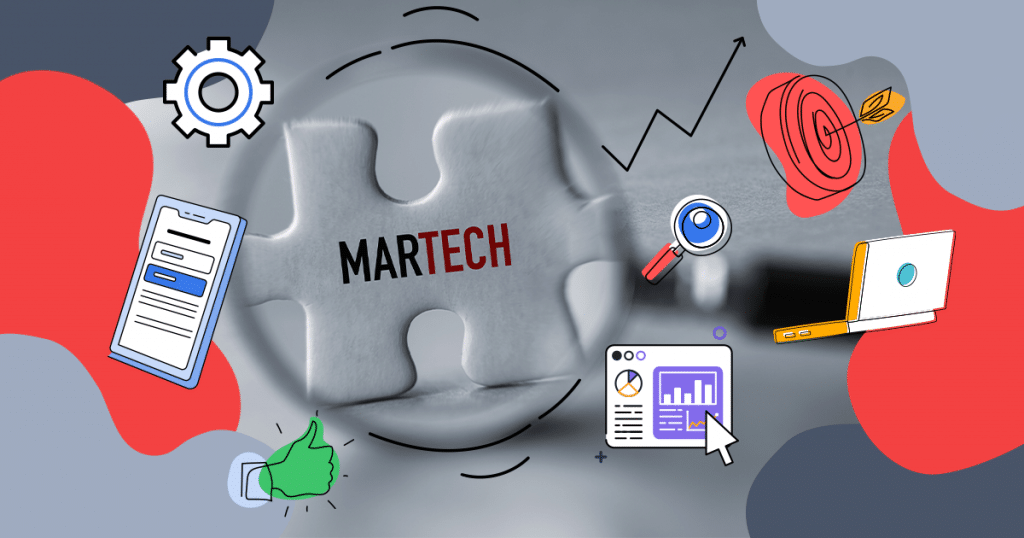More than ever before, digital marketing is being driven by the needs and wants of the consumer.
Consumers want brands to deliver experiences that utilize new technology as soon as it becomes available.
With that being said, it is imperative that companies and marketers stay abreast with MarTech and the latest advances in technology to stay on top of the expectations of existing and potential customers in order to deliver the best possible customer experiences.
Failing to do so could leave you in the dust behind your competitors.
So, let’s get to it, shall we? Here are 10 MarTech trends you’ll want to consider giving a try.
Download this post by entering your email below
1. Interactive Content
A unique experience is a must in today’s competitive environment, which is exactly why 81 percent of marketers report that interactive content is better than static content.
Interactive content is noticeable. It draws you in and doesn’t want to let you go.
Infographics, calculators, and videos are excellent tools for capturing the attention of individuals from the get-go and generating qualified leads.
As part of an overall content marketing strategy, interactive content can amplify your brand’s voice and presence online.
The notion is to ultimately enhance the user experience by using solutions that offer much more than just static information.
It is important to take care in selecting the right form of interactive content for each stage of the sales funnel, as this will increase the chances of converting the prospect into a buyer.
Interactive content comes in many forms, including:
- Polls and surveys
- Webinars
- Ebooks
- E-mails
- Mobile games
- Apps
- Flowcharts
- Diagnostics tests
- Troubleshooting tools
- Augmented reality media
- Interactive 360º videos
When creating interactive content, ensure you have a solid design, map out the needs of your customer, and keep the content shareable. This will increase your overall success rate.
Although listed as a trend here, interactive content is quickly becoming a staple in the MarTech and Digital Marketing industries.
2. Virtual Reality
Virtual reality isn’t exactly a new concept, but it is a bit of a newer player in the marketing industry.
And since its inception, it has definitely skyrocketed. This virtual reality market is projected to grow up to $209 billion by the year 2022.
This isn’t unexpected, seeing as how the world was turned upside down due to the COVID-19 pandemic when virtually everything turned digital and “virtual”.
Using virtual reality in marketing allows brands to bridge the gap that is placed between action and user experience.
It is cutting-edge technology that has the potential to literally disrupt the customer journey and immediately convert them into a buyer.
Virtual reality can be used to offer a digital experience for customers in place of a physical one, promoting a service or product.
It can even be used to showcase the development process or allow consumers to see how a particular product would look in their home before making a purchase.
Ultimately, virtual reality marketing brings consumers to you rather than you needing to put an exorbitant amount of effort into luring them to you.
3. Low and No-Code Platforms
Although you haven’t needed to be an IT expert in some time in order to deliver results, the number of low and no-code platforms available at your fingertips is abundant — and this number continues to rise annually.
This particular market is expected to go over $21 billion by 2022, and 75% of businesses are expected to use low and no-code platforms.
No wonder it made the list of top MarTech trends to try in 2022!
With these tools, you can develop technical applications, such as databases, websites, chatbots, and apps, with absolutely zero previous programming knowledge.
With this kind of programming, the technical barriers are lowered. Further, you get an increased delivery speed of applications, decreased costs, and higher productivity.
Just keep in mind that you can obtain quick results with low and no-code platforms, but due to the less extensive programming, the personalization options are limited.
Low and no-code platforms are creating opportunities and shaking things up, as they have the cost-effective ability to help businesses gain a more competitive edge.
4. Data Access and Customer Data Platforms
You’ve probably heard: the future is cookieless. Not in the chocolate-chip cookie sense, but in the third-party consumer data-driven sense.
After early 2022, as soon as Google finishes its phase-out, there will be no more third-party consumer data available to businesses.
Other browsers, such as Firefox and Safari, have already taken measures to remove third-party cookie tracking.
Without cookies, it would be much more difficult to gain insight into consumer behaviors. However, that doesn’t mean it is impossible.
Instead, businesses will simply need to look for new strategies to obtain consumer data, which means finding ways to reach out to existing and prospective customers.
Customer Data Platforms will be used more frequently and strategically to create a customer view.
These can be incredibly beneficial in obtaining data and creating unique profiles for individual customers in a single database.
Since there will not be a third-party cookie used to request a customer’s permission for their information, there will be privacy concerns for the use of CDPs in 2022 and beyond.
However, more often than not, data used in CDPs is zero or first-party data, such as newsletters, polls, surveys, follow-up e-mails, etc.
5. Influencer Marketing Platforms
Bringing influencers on as part of your overall marketing strategy can help your brand reach audiences you otherwise would never have reached.
This is probably why 65% of businesses have the intention to increase this part of their budget moving forward and why the market is expected to reach $15 billion by 2022.
Unfortunately, it is a time-intensive process.
In order for influencer marketing to be effective, you must find relevant influencers who have a minimum number of followers, reach out to them via DM or e-mail one by one, negotiate the terms/rates of the deal, and then track the results individually per influencer.
While the benefits are there, some businesses don’t want to mess with it.
Luckily, there are a number of influencer marketing platforms entering the market to take a load off your shoulders.
These platforms make it easier to locate influencers who will work for your brand and contact them.
6. Hybrid Events
When the COVID-19 pandemic shut down basically everything from live performances to craft shows, people were devastated. A lot of businesses took major hits and losses.
Although companies are slowly recovering and large events are starting to be allowed again, the fact remains: nothing will ever be the same again.
For one, some consumers are still uncomfortable being in large crowds. There is a good chance this hesitation will continue for some time, if not forever.
So, as a business, how do you respond? How do you keep your business afloat? How do you cater to both types of consumers: the ones that want to remain home and the ones who want to attend organized events (while still remaining safe)?
Keep in mind that a hybrid event does not simply mean streaming presentations to someone at home.
A hybrid event is where the online attendee receives the same experience as the in-person attendee, which means they get the same interactivity, networking opportunities, etc.
Creating a hybrid event will help you meet the needs of all of your existing and prospective customers.
This is exactly what Meeting Professionals International did with WEC Grapevine when in-person events were allowed to come back last year.
There were two events that were simultaneously planned and executed perfectly. There were 700 people who attended the event in person and 1,000 who attended the event virtually.
All in all, the event was a huge success, providing everyone with a safe and amazing experience.
There are, of course, challenges to planning an event that is both live-streamed at home and live in person.
However, a hybrid event like this ensures everyone walks away feeling satisfied while also providing brands with a broader audience reach, increased ROI, and deeper data insights.
It is important to manage expectations from the get-go and choose to work with the right platform provider so both virtual and in-person audiences are receiving an engaging and immersive experience.
7. Artificial Intelligence and Machine Learning
Machine learning and AI are both already being used regularly in multiple types of MarTech solutions. Chatbots, webinar services, and other assets are all great ways to leverage artificial intelligence and AI in a way that improves your marketing and outreach.
AI and machine learning can be applied at the macro and micro levels. AI can figure out how to segment your customers into specific buying groups or help accumulate data to make your data models stronger.
This is one of several marketing technology trends to keep an eye on since it will continue to become more prominent in the future.
8. Chatbots
Chatbots are an excellent option to add to your websites and are an element of MarTech that have express value. Customers and consumers no longer want to wait for open hours to chat with an agent, but you may not be able to have an agent online 24/7. That’s where chatbots come into play.
Chatbots are available 24 hours a day, seven days a week, and can answer commonly asked questions or route the most important customer service needs to the correct department.
Chatbots are going to continue to become more human-like over the course of the next decade or so, making it realistic that you could employ a single bot to take care of all your online customer service needs.
Current chat and voice bots, like Microsoft Cortana and Google Assistant, are showing that the use of this technology is promising and continues to grow in value over time.
9. Wearable Integrations
Wearable tech doesn’t always seem like it would work well for marketing, but it can be an amazing extra piece of technology that keeps people informed about sales and other information. Wearables offer new ways for you to reach your audience and build connections.
For example, you could send a notice to someone who is searching for a local sporting store, or you could trigger a notification as they pass by.
In this way, wearable integrations cannot be beat, because they have instant reach. Reaching the right shoppers at the perfect moment can take someone from being on the fence about a purchase and push them toward making the commitment. This increase in conversion rates is a big win for your company.
10. User Experience
Customers today do expect that they will be able to experience smooth, user-friendly operations online. Whether they are shopping online or just browsing a website, they want it to work well and to avoid things like glitches or annoying ads.
Personalizing the experience each user has is something that will become even more important in the future. In 2022, there will be a push toward developing more engaging UX and aiming to provide that more personalized experience to users to keep them engaged.
Creating a marketing strategy that keeps users on your website is something that will help boost your conversion rate and the likelihood of users returning to buy from you again in the future.
Wrap Up
MarTech trends are a primary focus for businesses in 2022, as business growth will be a priority in the new year and advanced marketing tools can help achieve these goals.
Before long, any marketing-related efforts will rely on MarTech solutions. Unfortunately, not enough businesses are familiar with these resources or how to implement them correctly to realize success.
The good news is that it isn’t nearly as hard as one may think.
As you embark on the new year and look to bring your business to new levels of growth and success, consider implementing a new marketing strategy.
Check out this free 2022 Marketing Planning Bundle that will help get you started on planning your best year yet!




![[ROCK NA] [EBOOK SEO] Complete Guide](https://rockcontent.com/wp-content/uploads/2024/06/banner_Search-Engine-Optimization.png)






